Coca-Cola’s Slogans and Images over the Years
The slogans which the Coca-Cola Company used to advertise their products naturally changed over the years. They understood that it was important to integrate and reflect the mentality of their time, as can be seen when looking at their advertisement slogans and pictures.
This adaptability probably is the reason why this Company has grown and remained so successful for the last 118 years.
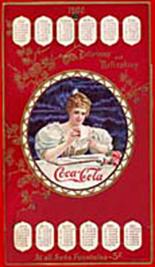 | 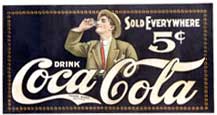 | 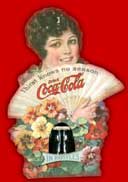 | |||
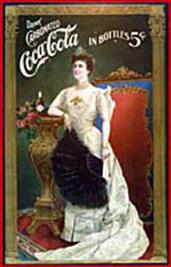
1886 DRINK COCA-COLA 1904: DELICIOUS AND REFRESHING
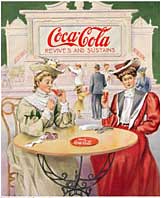 |
1907: GOOD TO THE LAST DROP
1905: COCA-COLA REVIVES AND SUSTAINS
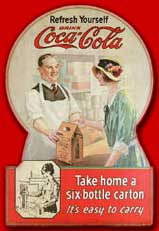 |
1922:THIRST KNOWS NO SEASON 1924: REFRESH YOUSELF
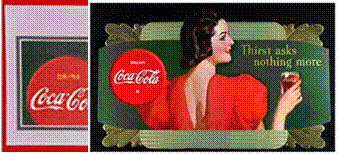 | 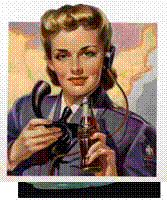 | ||
1929: THE PAUSE THAT REFRESHES
1935: FRIENDS FOR LIFE
1942: THE ONLY THING THAT TASTES IS COCA-COLA
1939: THIRST ASKS NOTHING MORE LIKE COCA-COLA
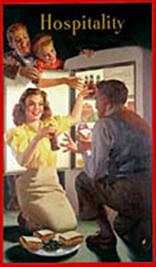 | 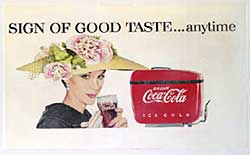 | ||
1948: WHERE THERE IS COKE THERE IS HOSPITALITY
1950: A SIGN OF GOOD TASTE
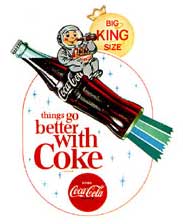 | 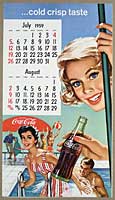 | ||
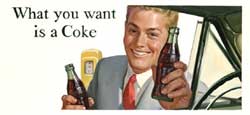 |
1952: WHAT YOU WANT IS A COKE
1958: THE COLD CRISP TASTE OF COKE
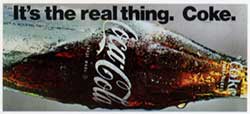 |
1963: THINGS GO BETTER WITH A COKE
1969: IT’S THE REAL THING
1974: LOOK UP, AMERICA
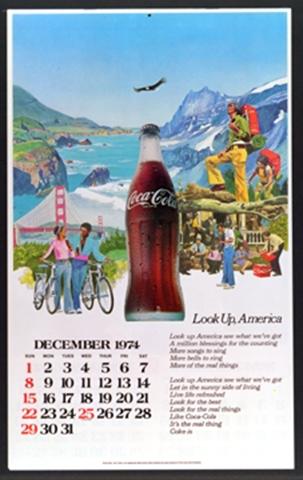
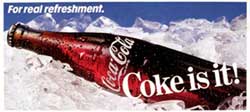
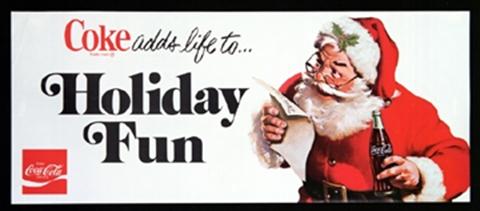 |
1976: COKE ADDS LIFE TO HOLIDAY FUN
1976: COKE ADDS LIFE
1982: COKE IS IT!
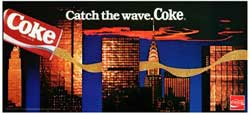
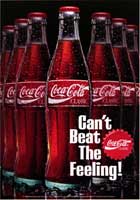 |
1986: CATCH THE WAVE (COCA-COLA)
1987: WHEN COCA-COLA IS A PART OF YOUR LIFE YOU CAN’T BEAT THE FEELING
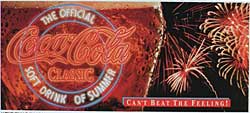 | 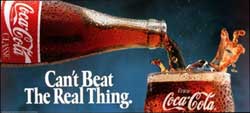 |
1989: THE OFFICIAL SOFT DRINK OF SUMMER
1990: YOU CAN’T BEAT THE REAL THING
Contemporary Advertising
With the changing media used by advertisers, advertisement itself changed quite a bit. So far the ads tried to present a product and make the consumer believe in the big advantages of it. Today, advertisers try to create certain images around their products, which draw a greater attention to the customers and makes them stick this specific product. This so-called “creative revolution” had its origin in the 1950s and 1960s when prominent advertising agencies stated that good advertising has to begin with the respect for the public’s intelligence and therefore have to be understated, sophisticated and witty.
This statement is even more important for today’s commercials on TV, since the technology has made it possible for the viewer to use the remote control to change the channel while the commercials are on. If it is not interesting to the viewer he will simply flip to another channel avoiding the commercial. New digital devices make it even possible to edit out commercials in order to watch a “commercial free” movie or show.
Methods of advertising
Television has attracted about 23.4 % of the money spent on advertising in the US in 1999. It is available in broadcast or cable form and generates a big platform for advertising. To run commercials on TV, advertisers have to buy units of time which range from 15 over 30 and up to 60 seconds in length. These spots are the most expensive ads and can cost up to millions of dollars depending on what time they are aired. If we just think about the ads shown at the major sports events in the U.S.A., like the Super Bowl or the Olympic Games. Only very economically powerful companies can afford this.
The combination of sight, sound and motion creates a more dramatic form of advertising which is considered to build a product’s brand image or to create an excitement around a special event such as a one-time sale. These ads are not intense enough to provide the viewer with a lot of information and are therefore only useful for products which are already familiar to the costumers.
Newspapers are an important media as well. Their advantage is to reach readers of different age groups, ethnic backgrounds and income levels. They display photographs and illustrations, giving explicit and detailed information about a product, new inventions and product improvements. Their disadvantage is that they can’t create such an emotionally strong image as the TV ads, but the opportunity to present coupons for special products shows a great popularity amongst customers, and is often used.
Direct mailis another kind of advertising, sending the ads via mail system to the future customers. This system is also used through e-mails and offers graphics and links to more information. In order to do this kind of advertising, the advertisers have to buy so-called mailing lists, which contain the addresses of people with certain wanted characteristics. Many advertisers consider this system the most effective, because it is much cheaper than mailing the advertisements and it is launched right at the target group.
Radio usually reaches a smaller group of people, mostly from one specific area. This gives local businesses the chance to broadcast their very specialized ads. Most people listen to these ads when they are driving in their car, so they will be informed of any kind of sales in stores in their region. They will hear them before they go shopping and might be tempted to buy these products. These ads have to be very simple and easy to be understood, since people are usually doing something, like driving, when listening to them.
The Yellow Pages are thick directories of telephone listings and displays of advertisements, mostly of local use, but nevertheless very effective.
Magazines only ranked sixth in the total spending on advertising in the U.S.A. in 1999. They are very specialized and target the reader of such magazines who usually have very similar interests. If you think about the highly specialized women magazines, displaying make up and other cosmetic products reaching for teenage girls to older women. This magazines are very prestigious because they show beautiful color photographs of the celebrities of today’s pop-culture.
Advertising on the Internet is becoming more and more popular among companies, since the majority of young consumers have online access at home. They range from banners, buttons, pop-ups to sponsorships of homepages, which we have been discussed in our course. This form of advertising gives the opportunity to check out the given information right away and most of the time allows the customer to order the product online without even leaving his or her home.
The last group of advertising I want to talk about is Outdoor Advertising which is launched via huge billboards to a highly mobile audience which is on the road very often. In cities like New York and the world’s metropolises, these big boards are part of the appearance of the city. People commuting to and from work will pass them, and subconsciously take them into account. This type of advertising has the lowest cost per exposure of any kind of advertisement. The boards are colorful, big and simply hard to ignore, and that’s what makes them effective.
The Impact of Advertising
The advertising business has become such an important factor in the economy in many countries, especially in the United States, that it also changes the economy itself, society, culture, and the political system.
The stimulation for the demand of products and services helps the economy grow stronger and stronger. New inventions become known much faster and can establish their spot in the sales figures of the economy. If there are more people buying these products the overall costs will drop and the product will become cheaper for the customer which raises his willingness to buy even more. On the other hand advertisements are very expensive and some economists believe that these costs are put on top of the actual price paid by the customer.
Critics argue that advertising can also have a huge influence on society. It tells the consumers that only purchasing products makes you happy and therefore people compare each other on their belongings. Women also compare themselves with the beautiful and very skinny models they see on commercials and ads. This sometimes results in eating disorders and a low self-esteem of women who don’t look like these models. Another bad effect is, that minority groups, especially in the United States are portrait in a subordinate position, which settles in the minds of people. Commercials are also an important part of the income of a TV station which leads to the suspicion that a news channel might not report on an incident about a company they depend on. A lot of TV shows are also based on these commercials, and if the ratings aren’t good enough the show will be stopped. Only those shows which attract a lot of viewers will be shown, which is not very differentiated and put minorities like older people at a disadvantage.
Advertising can also have an impact in politics. $ 467 million were spent on advertisements and TV commercials in the elections of 1998. It gives the opponents the chance to respond to charges very quickly reaching a few million viewers. But since this is very expensive only very rich people have to chance to run for a political position or at least depend on the donation of wealthier people who could have a huge impact on democracy this way. The political issues talked about in an election are also very much simplified because the spots are only about 30 seconds long, and you can’t really discuss a lot in such a short period of time.
There is finally the impact advertising can have on the culture of a country. The globalized economy uses the same commercials in a lot of different countries, which leads to a break down in the differences of these societies. Children will grow up not knowing how their culture has been before in their country. It can also lead to a lot of discussion about moral values if we just think about the very controversial ads of Benetton we have discussed.
Glossary
Some terms can be useful in providing a common vocabulary with which to discuss and analyze mass media and the processes involved in media construction.
Ad lib - extemporaneous talk by radio performer.
Advertising - any paid form of nonpersonal presentation of ideas, goods, or services by an identified sponsor.
Advertorials, info-mercials - paid announcements in print or screen media designed as an entertainment or educational presentation.
Aerial shot - a shot from a crane, plane, or helicopter.
Air date - the date on which a program will be broadcast.
Air time - the time at which a radio program is broadcast.
Animation - the process by which inanimate objects or drawings are made to appear to move on the screen.
Bias - a preference that interferes with objective judgements.
Broadcasting - the transmission of radio or TV signals on frequencies available to anyone with basic receivers.
Broadcast medium - a medium such as radio or television that sends electronic signals through the air or cables.
Camera angle - the position of the camera relative to the horizontal plane of the subject. In a high-angle shot, the camera is above the subject; in an eye-level or flat shot, the camera is on the same plane as the subject; in a low-angle shot, the camera is below the subject. Camera angles should make sense within the context of the shot.
Camera distance - the apparent distance of the camera from the subject (extreme close (XCU), close-up (CU), medium shot (MS), long shot (LS)).
Camera movement - an actual or simulated movement relative to the subject:
- pan - slow, steady movement across a scene from a fixed point
- follow - like the pan, but the camera is directed at an individual or object as it moves through a scene
- tilt - a vertical pan or follow
- zoom in and zoom out - use of the zoom lens to approach or back away from the subject
- dolly or track - use of a wheeled vehicle to move the camera alongside, toward, or away from the action.
Casting - the selection of individuals who will appear in a film or program.
CD-ROM - a compact disc that contains software in a multimedia format.
Cinematographer - the person responsible for photographing the film.
Close up (CU) - shot in which an important detail, object, or facial expression fills the screen.
Communication - the exchange of messages between a sender and a receiver in which the message is understood by the receiver; the process by which messages are formulated, exchanged, and interpreted.
Composition (visual media) - the placement and use of all the various elements in the frame of a movie, television show, or photograph in order to achieve maximum impact.
Continuity- the scripted part of a documentary program which introduces the topic, connects the various components (usually recorded interviews), and concludes the program; provides coherence to the disparate components of these programs.
Cut - the immediate change from one shot to the next.
Cut (noun) - a piece of tape which is edited and ready for use, or a complete song from an LP, cassette, or CD.
Cut (verb) - the physical process of editing or cutting audiotape.
Cyberspace - the electronic environment created by the links among computers and other electronic equipment such as satellites.
Dead air - the period of time when no programming is being broadcast, even though radio station is "on the air".
Delivery- an oral presentation on radio; effective voice qualities (e.g., pitch, tone, diction, and pace) that enhance the verbal message.
Director- the person responsible for the creative interpretation of the script, story, or issue and the supervision of its filming and editing.
DJ (disk jockey) - a host/announcer of a radio music program.
Docudrama - a semi-fictionalized film or program that mixes documentary footage with dramatic scenes or re-enactments.
Documentary- a factual film about a particular subject or a radio program which treats an event or issue in depth.
Dominant Culture - a societal group with power or authority.
Dub- an electronic process of duplicating a tape.
Editing (print media) - a process of selecting and arranging items and of revising writing in newspapers, magazines, and other print media.
Editing (sound) - a process of arranging and bringing together all the individual soundtracks (e.g., dialogue, sound effects, music) and combining them onto one master track.
Editing (visual) - a process of selecting, arranging, and combining shots.
Episode- one show of a television series.
Establishing shot (ES) - generally a long shot or extreme long shot used to show the setting.
Extreme close up (ECU) - a close up in which a small detail fills the entire screen.
Extreme long shot (ELS) - a very wide shot, often a panoramic view.
Fade-in - a shot that begins totally over or under exposed (white or black) and gradually becomes properly exposed.
Fade-out - a shot that ends by changing from the proper exposure to an extreme under or over exposure.
Fast motion - the opposite of slow motion (i.e., filmed at fewer than 24 frames per second).
Format- the overall concept of a radio station’s sound (includes factors like music, news, personalities, with number and placement of "spots" and "jingles"; may be a broad overall idea or highly detailed rigid set of slogans and top songs that are endlessly repeated).
Frame - a single, still image from a film or video.
Freeze frame - an effect in which a single frame is held on screen for an indefinite time.
Gaffer - the chief electrician responsible for lights.
Gatekeepers- the people who determine what will be printed, broadcast, produced, or consumed in the mass media.
Genre - a way to classify prose, poetry, drama, and other media.
High angle shot - a shot in which the camera looks down upon the subject from a higher vantage point.
Icon - a highly valued person or product in popular culture.
Ideology - a system of beliefs that is characteristic of a particular class or group.
Interactive - able to be affected or changed by something the user does; most CD-ROMs are interactive.
Jingle - recorded singing, usually of station call letters or slogan.
Jolts- a term used by the commercial television industry to refer to moments of excitement generated by visual and/or aural techniques.
Juxtaposition - the positioning of items side by side or close together.
Kicker - a humorous or light-hearted story sometimes used at the end of a newscast.
Live- material that is not recorded but is broadcast as spoken; the acoustical quality of a room or area that causes a great deal of reverberation.
Log - a legal record of radio station operation; there are two types--a "station" or "program" log which indicates placement and length of required program material, including commercials, and a "transmitter" log which indicates technical readings and changes.
Logo- a distinctive identifying symbol for communication, publication, or screen presentation.
Mainstream media - media created for and favoured by large numbers of people in society (related to popular culture).
Market - a potential listening audience in the area the radio station broadcasts; potential buyers of the products and services advertised by the radio station.
Marketing - the process of promoting and selling a product or service based on decisions about what the product image should be and who is most likely to buy it.
Mass media - media such as television, radio, and newspapers that can reach a large group of people.
Media - the plural of medium.
Media effects - a general term that refers to the consequences or impacts of media use on individuals, society, and culture.
Media event - a reported event that appears to be news, but is actually staged by an individual, group, or government.
Media literacy - an understanding of media methods and messages.
Medium- a format for communicating messages.
Medium shot (MS) - a medium close shot in which the head, shoulders, and chest are normally included in the frame.
Mixer - an electronic device which receives input from a variety of sources and mixes them to produce a single output.
Mixing - the actual combining of sound from different sources; usually done through the "audio board" or "mixer".
Montage - a sequence of shots cut together often in a stylized way, to suggest a theme or idea rather than a continuous event.
Multimedia - format that combines such elements as sound, text, photographs, and moving video images.
Narration - a scripted voice-over commentary, read by a narrator or participant in a film.
Network - a system of many computers connected together; a company that distributes programs for broadcast.
Nonverbal - communication that relies on visual messages.
Output- sound from a tape recorder, amplifier, mixer, or other piece of equipment; may be in the form of electrical energy or sound.
Pan- short for "panoramic" shot; a horizontal movement in which the camera is turned from the left to right or right to left to follow a moving subject or give a sweeping view across a scene.
Personal media - media that grants control over the outcome of the communication process to the user (e.g., VCRs, personal computers, video games).
Picture editor - the person responsible for cutting the picture in the editing room.
Point of view (POV) - a subjective shot that shows the point of view of a particular character.
Popular culture - widespread, prevalent, and current trends or fads; arts, customs, beliefs, and all other products of human thought made by and favoured by large numbers of people in a society.
Prime time - the most popular time to watch television.
Print codes - the codes which help the reader understand the newspaper or magazine and which have an impact on the reader’s response.
- layout and design - include colour, typeface, arrangement of stories, photographs, advertisements, bulletins, and size of items on the page; often have a significant influence on reader response
- caption - includes one or two lines of print under a photograph or other illustration
- inverted pyramid pattern - the hypothetical structure of newspaper stories.
Print media - any presentation that uses paper.
Producer- the person who plans, co-ordinates, and supervises the overall production of a film, including personnel and budget.
Production manager - the person responsible for the shooting schedule and for solving problems on location during filming.
Programming (television) - the types of programs shown and their placement in the schedule.
Propaganda - the information and opinions that are intended to convince people to accept or reject a certain idea.
Ratings - the periodic measurement of a radio or television station’s audience size.
Rough cut - the first assembly of a film or program in which selected shots are edited together.
Rushes (or dailies) - film that is processed as soon as possible after shooting so it can be viewed by director and crew.
Scene- a clearly identifiable part of an event, usually in a single location and in a single time span; it generally consists of several shots.
Screen media - motion picture, television, and computer messages presented on a flat panel.
Screenplay - a dramatic script for a film or television program that includes both dialogue and action descriptions.
Sequence - a series of scenes shown together (related by theme, plot, or location) that make up an organic whole and that has a clearly identifiable beginning and end; usually several sequences are put together to make even a short film.
Shooting script - a detailed script for a dramatic film or program in which the action is broken down shot by shot.
Slow motion - action which appears to happen at slower than normal speed.
Sound editing - stage in which sound effects and music are added to program.
Sound effects (SFX, FX) - sound from any source other than voice-over narration, lip-sync, or music.
Speaker - a device which converts electrical energy to sound.
Spin-off - a television show or video game based on the ideas or characters from another source.
Split screen - an effect in which two or more shots occupy different portions of the scene at the same time.
Spot- a radio term for a commercial or public service announcement.
Stereotype - a highly opinionated, predictable, biased, and simplistic view.
Storyboard- a "short shot" script which includes drawings of each shot for a movie or for some television shows.
- Three main elements: a description of the shot (e.g., medium shot, low angle, camera movement); a drawing of the shot; a description of the sound (dialogue, music, effects)
- Formats differ and are dependent on the needs of the creator and the type of media text being produced.
Subject (visual medium) - what the image in the frame of a movie, television show, or photograph represents.
Synchronized sound - the matching of sound to action on the screen.
Tabloid -technically, a publication usually half the size of a standard newspaper page; commonly used to refer to a splashy, heavily illustrated newspaper; a "supermarket" newspaper stressing dramatic stories, often about sensational subjects.
Tag- a scripted closing to a tape story, usually identifying the speaker/reporter and location; may also be used by the in-studio announcer at the end of a "remote" report; may be a commercial or public service announcement for a particular market.
Target audience - specific groups of people that media producers or advertisers want to reach.
Technological communication - communication by the newer technologies of film, videotape, and electronic media such as e-mail and the Internet.
Telecommunications media - sometimes refers to all forms of electronic media; media that permits point-to-point interconnectivity and interactivity.
Telecommute - to use computers, modems, and telephones to support work at home; a substitute to the traditional office.
Tracking shot (dolly shot) - a shot in which the camera is mounted on a wheeled platform or dolly to create smooth, steady movements.
Travelling shot - a shot taken from a moving vehicle.
Turntable - a record player without an amplifier.
Video essay - a video which presents factual information about a specific topic.
Videotex - an information system providing for consumer control over interactive cable or telephone lines; can be used for information storage and retrieval, in-home banking and shopping, and other interactive communication.
Virtual reality - a computer-created world that seems very real.
Visual communication - any optically stimulating message that is understood by the viewer.
Voice over (VO) - a voice or commentary recorded for use on the film’s soundtrack.
Wire copy - news material written by wire services (e.g., Canadian Press, United Press International); news gathered from around the world and transmitted to subscribing newspapers, radio, and television stations via telephone lines.
World Wide Web - a large directory of information on the Internet.
Zoom shot - camera shot that creates the illusion of moving toward or away from a subject simply by changing the focal length of the lens. A Zoom In magnifies objects to make them appear close; a Zoom Out widens the angle view, making objects appear to move farther away.
HOLLYWOOD
Hollywood is a district in Los Angeles, situated west-northwest of Downtown Los Angeles. Due to its fame and cultural identity as the historical center of movie studios and movie stars, the word "Hollywood" is often used as a metonymy of American cinema, and is often interchangeably used to refer to the greater Los Angeles area in general. The nickname Tinseltown refers to Hollywood and the movie industry. Today, much of the movie industry has dispersed into surrounding areas such as the Westside neighborhood, but significant auxiliary industries, such as editing, effects, props, post-production and lighting companies, remain in Hollywood, as does the backlot of Paramount Pictures.
Many historic Hollywood theaters are used as venues and concert stages to premiere major theatrical releases and host the Academy Awards. It is a popular destination for nightlife, tourism, and is home to the Hollywood Walk of Fame.
Although it is not the typical practice of the city of Los Angeles to establish specific boundaries for districts or neighborhoods, Hollywood is a recent exception. On February 16, 2005, California Assembly Members Goldberg and Koretz introduced a bill to require California to keep specific records on Hollywood as though it were independent. For this to be done, the boundaries were defined. This bill was unanimously supported by the Hollywood Chamber of Commerce and the Los Angeles City Council. Assembly Bill 588 was approved by the Governor on August 28, 2006, and now the district of Hollywood has official borders. The border can be loosely described as the area east of Beverly Hills and West Hollywood, south of Mulholland Drive, Laurel Canyon, Cahuenga Boulevard, and Barham Boulevard, and the cities of Burbank and Glendale, north of Melrose Avenue and west of the Golden State Freeway and Hyperion Avenue.
As a portion of the city of Los Angeles, Hollywood does not have its own municipal government, but does have an official, appointed by the Hollywood Chamber of Commerce, who serves as an honorary "Mayor of Hollywood" for ceremonial purposes only. Johnny Grant held this position for decades, until his death on January 9, 2008.
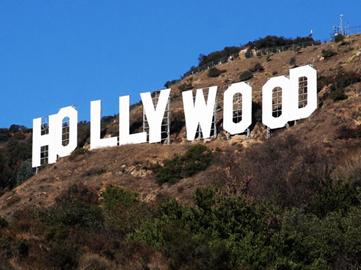
The Hollywood Sign, the worldwide symbol of the entertainment industry, was conceived as an outdoor ad campaign for a suburban housing development called "Hollywoodland."
After all, despite the high profile of the film biz, real estate has always been Hollywood's primary economic driver.
Although the Sign's appearance and purpose have evolved over the years, its basic aspirational message remains the same: This is a place where magic is possible, where dreams can come true.
Back then, the dream was a beautiful home and lifestyle. Today, the Sign's promise is more subtle - and can only be described as the parade of images, desires and ideas conjured by the word "Hollywood."
Imagine a time when the only stars in Hollywood were found in the crystal- clear night skies arching over rolling hills.
This was the setting for the area's native people, the Gabrielinos. Later, the Gabrielinos lived on missions for some time but reminders of their culture remain.
Before Hollywood became the world's entertainment Mecca, it resembled other west frontiers - a landscape of farmers, cowboys, prospectors, bandits, and mostly undeveloped land. All land north of Sunset Boulevard, for example, was considered useless for anything but grazing.
With more and more Easterners drawn by the promise of sunny skies and mild, dry weather, the area's bedrock industry - real estate - soon kicked into high gear.
Subdivisions begat more subdivisions, and by the end of the 19th century Hollywood was taking on the contours of a recognizable town. Thanks to Daeida Wilcox, it also had a name.
In 1887, Mrs. Wilcox, wife of town founder Harvey Wilcox, met a woman on a train trip who referred to her Florida summer home, "Hollywood." She was so struck by the name that she suggested it to her husband ... and the rest is history.
All was quiet until 1907, when bad weather drove a small Chicago film company westward to complete a shoot.
The first real studio, Nestor Film Company, soon followed from New Jersey, cranking out three pictures a week - one 'western,' one 'eastern,' and one comedy - for a grand total of $1,200.
By 1912, word of Hollywood's ideal film-shooting climate and landscape spread, and at least 15 independent studios could be found shooting around town. Old barns were turned into sound stages and Hollywood's quiet time was over.
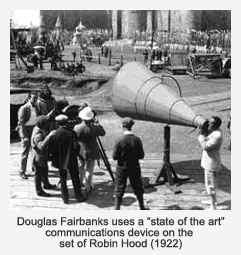
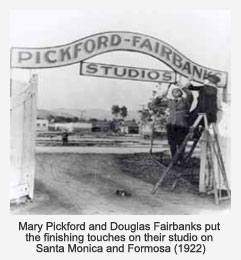
By 1915, America was officially film crazed, and Hollywood was shaping into the glamorous, sometimes surreal landscape we've come to know and love.
Hopeful actors and actresses filled the streets, dazzled by a new American dream: film stardom. Studios, meanwhile, sprung up like wildfires and engaged in a cutthroat battle for survival. As the industry matured, many of these independent companies merged, forming the big studios that would shape and control the industry moving forward.
By 1920, 40 million Americans were going to the movies each week. As the industry blossomed, Hollywood strove to keep pace physically. L.A. history buffs (and fans of the movie Chinatown) know the key to the area's explosive development during the early 20th century was the Owens Valley Aqueduct System, spearheaded by William Mulholland (who was the head engineer of the Municipal Water Department) and initially completed in 1913.
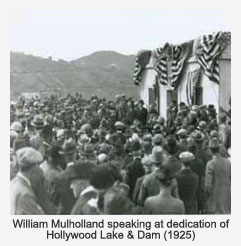
Still, the water flowed (usually), and Hollywood flourished. During the 20s, a whimsical skyline of movie set-inspired hotels and apartments rose along the big boulevards. The more prestigious addresses, including the opulent Garden Court Apartments, Chateau Elysee and Garden of Allah Villas, were imbued with the glamour of the stars that called them home.
Hollywood, which by now represented not just a city, but also an industry, a lifestyle and, increasingly, an aspiration, was officially crowned when the "Hollywoodland" sign was erected in 1923.
Built by Los Angeles Times publisher Harry Chandler as an epic $21,000 billboard for his upscale Hollywoodland real estate development, the Sign soon took on the role of giant marquee for a city that was constantly announcing its own gala premiere.
The "billboard" was massive. Each of the original 13 letters was 30 feet wide and 50 feet tall, constructed of 3x9' metal squares rigged together by an intricate frame of scaffolding, pipes, wires and telephone poles.
All of this material had to be dragged up precipitous Mt. Lee by laborers on simple dirt paths.
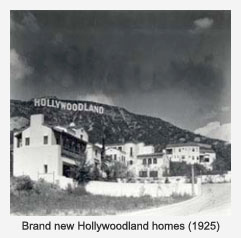
Few know that a giant white dot (35 feet in diameter, with 20-watt lights on the perimeter) was constructed below the Sign to catch the eye. The Sign itself featured 4,000 20-watt bulbs, spaced 8 inches apart.
At night the Sign blinked into the Hollywood night: first "Holly" then "wood" and finally "land," punctuated by a giant period. The effect was truly spectacular, particularly for pre-Vegas sensibilities.
Originally intended to last just a year and a half, the Sign has endured more than eight decades - and is still going strong.
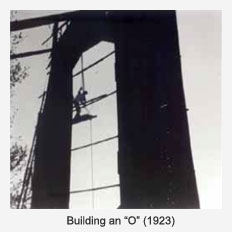
The advent of synchronized sound sent the picture industry reeling, as the big studios frantically re-tooled and acting careers were ruined and made overnight.
The "Hollywood Sign Girl"
The element of sound promised new opportunities for vocally trained stage actors. Unfortunately, most of the thousands of would-be stars and starlets who flocked to Hollywood were met with cold rejection.
In 1932, Peg Entwistle, a New York stage actress, became the symbol of the dark side of the Hollywood dream. Emboldened by her Broadway success, the ambitious young actress soon set her sights on the silver screen. She packed her bags for Hollywood and moved in with her uncle on Beachwood Drive - virtually in the shadow of the Hollywood Sign.
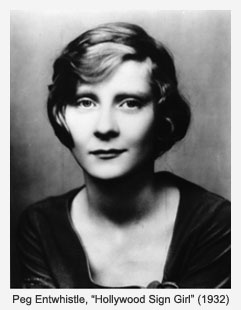
Unfortunately, Peg failed to make a splash, and she spent most of the brutally hot summer of '32 hanging around her uncle's house, waiting for a phone call that never came. Finally, on the evening of September 18th, Peg told her uncle that she was going to meet some friends at a nearby drug store, but this was a sad lie.
She instead made the arduous hike up the canyon hill to the Hollywood Sign, her one-time beacon of hope but now a symbol of failure and rejection. She climbed 50 feet up a workman's ladder to the top of the "H" and plunged to her death. Peg Entwistle - dubbed by tabloids as the "The Hollywood Sign Girl" - was only 24 years old.
In a cruel twist of irony, a letter to Peg arrived the day after her death from the Beverly Hills Playhouse. She was offered the lead role in a play ... about a woman driven to suicide.
When Japan attacked Pearl Harbor in 1941, Hollywood mobilized to become a full-time war industry.
Studio trucks transported troops instead of movie sets. Stars like Clark Gable, Jimmy Stewart and Victor Mature quickly enlisted. And patriotic fare dominated the silver screens.
The War also had a more subtle effect on moviemaking and creative choices. Out of physical necessity (rationing, travel limitations, etc.) spare psychodramas and the age of Film Noir replaced the costly extravaganzas of years past.
As the War progressed, Hollywood drew together as a close-knit community. Returning soldiers swelled the local population (outnumbering civilians 10 to 1 downtown) and Hollywood pulled together to feed, shelter and entertain them.
At first, sheer overcrowding meant that many soldiers had no choice but to sleep in parks and theater lobbies. But it wasn't long before 'Mom' Lehr's Hollywood Guild and Canteen began offering them beds and 'three squares' a day. On average, 800 servicemen stayed with 'Mom' on weekdays and 1200 servicemen on weekends.
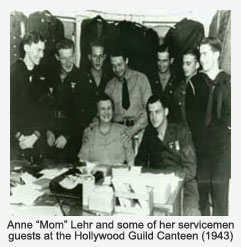
The similar-sounding Hollywood Canteen catered to 2,000 servicemen a night, offering free food and drinks as well as the era's top big bands and an endless parade of Hollywood's biggest stars.
It's estimated that 6,000 radio and screen entertainers volunteered to serve and entertain the troops at the Canteen during the War.
By the early 40s, the Hollywoodland real estate development went bust - a casualty of the Depression. The Sign, which hadn't been maintained in years, quietly became property of the city in 1944.
The Sign had made an unheralded transition from billboard to de facto civic landmark, but salvation would have to wait until after the War.
During the 1960s, Hollywood suffered through a mass exodus of residents to the suburban San Fernando Valley. Even more distressing was the flight of film power centers to the Valley and other less cramped environs. By 1970, Paramount was the only studio left in town.
In the void left by this civic and business flight, and against a backdrop of looser obscenity laws, redefining what could be shown in movie theaters. Hollywood became overrun with adult theaters, and the 'adult' culture they ushered in: massage parlors, porn shows, adult bookstores, etc.
Crime soared, and the town's storied boulevards were ravaged by the urban decay that marked most U.S. cities during the period.
Meanwhile, by the end of the turbulent 60s it didn't take a Weatherman to know what the elements had done to the Sign. Hollywood's once-proud emblem now served as a glaring badge of dishonor - rusted, dilapidated, soon to literally crumble under its own weight.
In 1973, the City of Los Angeles Cultural Heritage Board gave the Sign official landmark status (Monument #111), but the ensuing ceremony, hosted by silent film star Gloria Swanson, was blanketed in a thick fog, ruining the event.
It was a portent of dark days ahead for the city, and especially the Sign. During the 70s, as Hollywood continued to decline, the top of the "D" and the entire third "O" toppled down Mt. Lee, and an arsonist set fire to the bottom of the second "L."
Adding insult to injury, pranksters altered the Sign's letters to read "Hollyweed" in 1973 (advocating looser marijuana laws) then later, to "Holywood", commemorating a visit from Pope John Paul II in 1987.
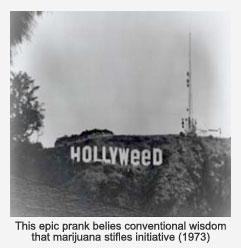
By the late 1970s, the Hollywood Chamber of Commerce determined that the Sign required a complete rebuilding - carrying a price tag of a quarter million dollars. Thankfully, some of showbiz's biggest names came to the rescue.
In '77, Fleetwood Mac pledged a charity concert, but local residents prevented it. The next year, however, Hugh Hefner hosted a gala fundraiser at the Playboy Mansion, where individual Sign letters were ceremonially 'auctioned' off at $27,700 per letter.
The effort to preserve the Sign brought together an odd mix of celebrity sponsors: Glam-rocker Alice Cooper 'bought' an "O" (in honor of Groucho Marx), while singing cowboy Gene Autry sponsored an "L" and Andy Williams sponsored the "W."
Thanks to the help of these and other donors, the Sign was poised for its overhaul. The old Sign was scrapped in August '78, and yes, for three lonely months Hollywood had no Sign.
194 tons of concrete, enamel and steel later, the Sign was re-born, poised and polished for a new millennium.
In 1980, a $90 million federal grant enabled Hollywood to launch a slew of redevelopment projects. In '89, Disney Studios began a museum-grade rehabilitation of the El Capitan Theater.
Ten years later, part of the Egyptian was restored to its glory. The Roosevelt Hotel and Pantages Theater all received well-deserved makeovers during the last decades of the millennium.
In short, Hollywood was moving forward, in part by wisely reinvesting in the monuments of its past.
Hollywood's civic restoration, which began in the 1970s, picked up steam in the ensuing decades, fueled by a growing reverence for what the industry had come to represent worldwide.
In 1992, the California Attorney General granted distinct legal rights and responsibilities to three official agencies - the City of Los Angeles (which owns the land the Sign stands on), the Hollywood Chamber of Commerce (which owns the licensing rights for the Sign's image), and the Hollywood Sign Trust (formed to maintain, repair and provide capital improvements to the Sign for the benefit of the public - with the larger mission of helping to preserve Hollywood's standing as the worldwide center of motion pictures and cinema arts).
Thanks to the Trust's efforts, the Sign got a fresh new paint job in 1995, courtesy of Dutch Boy Paints, during a ceremony hosted, appropriately enough, by Phyllis Diller (the 'queen of facelifts').
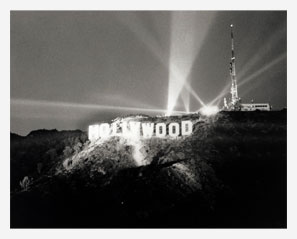
On December 31, 1999, the Sign was the site of the West Coast's highest-profile "Y2K" celebration, ringing in the new millennium with a dazzling display of lights and special effects.
The Sign was featured alongside the Eiffel Tower, the Great Pyramids of Egypt, and New York's Times Square during global millennium countdown TV coverage. The erstwhile real estate billboard continued its place among the world's most revered landmarks.
In 2000 the Hollywood Sign Trust hired Panasonic to install a state-of-the-art security system comprised of a vast closed circuit surveillance network, and Internet-based surveillance (which can be viewed live on the website). The system, which is monitored 24/7 to protect the Sign and its neighbors from unwanted visitors and the danger of fire, was upgraded with new technologies in 2005.
In 2004 the Sign celebrated its 80th birthday at a gala celebration hosted by movie musical legend Esther Williams (another remarkably preserved octogenarian). The 'birthday party' was held during the opening ceremonies for the AFIFest - which was sponsored in part by the Trust. In mid-2005, the Sign 'went into makeup' once again, and received another new sparkling white paint job.
Poised and polished for this millennium, the Hollywood Sign continues to inspire moviemakers and fans around the world, while playing a vital role in keeping the town it helped put on the map at the center of the global entertainment industry.
Through the years - from its splashy real estate billboard roots, to its long neglect and decay, to its current status as a revered international landmark - the Sign has emerged more symbolically powerful than ever. It conjures an ever-expanding parade of images, desires and ideas with just nine simple letters:

Hollywood glossary
| The backlot | Натурная съемочная площадка | |
| The Hollywood Walk of Fame | Голливудская Аллея Звезд | |
| The area’s bedrock industry | Основная (основополагающая, коренная) индустрия региона | |
| A shoot | Съемки | |
| History buffs | Любители (фанаты) истории | |
| Whimsical skyline of the city | Причудливые очертания города на фоне неба, горизонта | |
| Escapist productions | Развлекательная продукция | |
| To make a splash | Произвести фурор, громко заявить о себе, вызвать сенсацию | |
| Beacon of hope | Луч надежды | |
| Psychodrama | Психологическая драма | |
| Film Noir | Черный детектив, мрачный фильм, фильм-нуар | |
| Extravaganza | Буффонада, феерия, преувеличение в описании событий и чувств | |
| Close-knit community | Сплоченное сообщество | |
| Go bust | Прогореть, обанкротиться | |
| Mass exodus | Массовый исход | |
| Flight | Побег, поспешное отступление | |
| Obscenity law | Закон об ответственности за непристойное поведение | |
| Against a backdrop | На фоне | |
| It doesn’t take a weatherman to know | И к бабке не ходи, и так понятно | |
| Portent | Знамение, предзнаменование, дурной знак | |
| Silent film star | Звезда немого кино (а не молчаливая кинозвезда) | |
| Fundraiser | Благотворительная акция (здесь: благотворительный аукцион) | |
| Erstwhile | Некогда, прежний, бывший | |
| Mural | Настенная роспись, большой плакат | |
| Draw media coverage | Привлекать внимание средств массовой информации, попадать в заголовки, освещаться СМИ | |
| Putting green | Лужайка для гольфа | |
| Reference books | Справочная литература | |
| Motion pictures | Кинематограф | |
| Memorabilia | Предметы коллекционирования, собрание памятных вещей | |
| To be auctioned off | Быть проданным с аукциона, уйти с молотка | |
| The highest bidder | Участник аукциона, предложивший наивысшую цену | |
| Has been televised live | Идет в прямой телевизионной трансляции | |
| The bleachers | Трибуны, места на открытой трибуне | |
| Curbside | Co стороны тротуара (т.е. через правую дверь авто) | |
| Scalped tickets | Билеты, купленные по спекулятивным ценам | |
| Make the headlines | Попасть в заголовки газет, вызвать сенсацию | |
| Random drawing | Случайная выборка | |
| Bumper-to-bumper traffic | Очень плотное движение, «пробка» | |
| Yesteryear | Прошлый, относящийся к прошлому, прошедший | |
| Terrazzo | Терраццо (венецианская мозаика) | |
Ecology
Ecology is the study of environmental systems, or as it is sometimes called, the economy of nature. "Environmental" usually means relating to the natural, versus human-made world; the "systems" means that ecology is, by its very nature, not interested in just the components of nature individually but especially in how the parts interact. Ecology is technically an academic discipline, such as mathematics or physics, although in public or media use, it is often used to connote some sort of normative or evaluative issue as in something is “ecologically bad” or is or is not “good for the ecology”. More properly ecology is used only in the sense that it is an academic discipline, no more evaluative than mathematics or physics. When a normative or evaluative term is needed then it is more proper to use the term “environmental”, i.e., environmental quality or “environmentally degrading”. Most professional ecologists are not terribly unhappy when ecology is used in the normative sense, preferring the wider public awareness of environmental issues today compared to the widespread ignorance of three decades ago.
The subject matter of ecology is normally divided onto four broad categories: physiological ecology, having to do with the response of single species to environmental conditions such as temperature or light; population ecology, usually focusing on the abundance and distribution of individual species and the factors that cause such distribution; community ecology, having to do with the number of species found at given location and their interactions; and ecosystems ecology, having to do with the structure and function of the entire suite of microbes, plants, and animals, and their abiotic environment, and how the parts interact to generate the whole. This branch of ecology often focuses on the energy and nutrient flows of ecosystems, and when this approach is combined with computer analysis and simulation we often call it systems ecology. Evolutionary ecology, which may operate at any of these levels but most commonly at the physiological or population level, is a rich and dynamic area of ecology focusing on attempting to understand how natural selection developed the structure and function of the organisms and ecosystems at any of these levels.
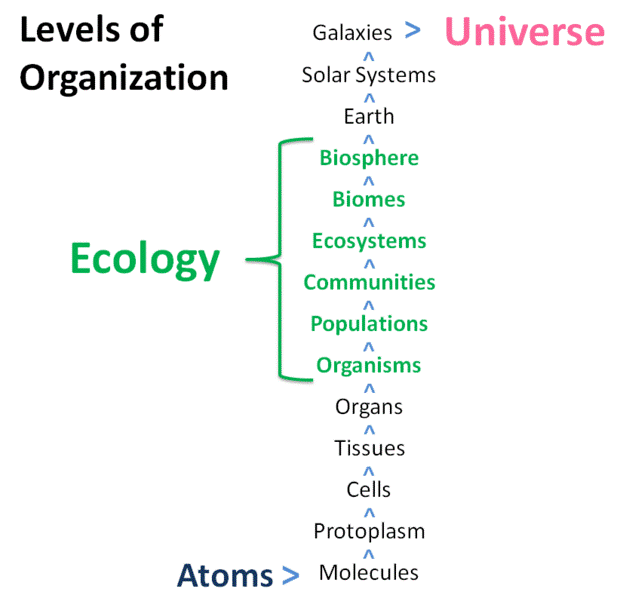
***
According to estimates from the international research organization, Global Footprint Network, today marks that day of the year when human impact and demands on the planet begin to exceed what Earth can support.
Basically, we’ve already spent our environmental budget for 2011. Imagine not eating for the next three months. Not consuming, or producing, or throwing anything away. The entire human race and all our systems are in a state of suspended animation from now until the end of the year. That’s how far from sustainable our demands and impact on the planet have become.
Since sometime in the 1970s, when world population was about 3.7 billion
the planet hasn’t been keeping up with the demands we’ve placed upon it — a condition known as ecological overshoot. Yet, according to UN estimates, world population will reach 7 billion next month — nearly twice what it was when we first crossed into unsustainability.
Of course, population is but one factor in ecological overshoot. In the near term, the emerging economies of the developing world will stress the planet far in excess of what population growth alone would suggest.
Global Footprint Network calculates that it would now take between 1.2 and 1.5 Earths to sustainably support our current ecological demands. Before mid-century, we’re likely to require the resources and regenerative capacity of two Earths.
Critics may claim that it’s impossible to calculate with any accuracy the ability of the Earth to support human needs, just as it’s impossible to arrive at an accurate count of world population. While true, such thinking misses the point.
Whether the day of environmental overshoot is today, last month, or next month, evidence that we are well past the threshold of sustainability is everywhere, from rising food and energy prices, to depleted aquifers, disappearing species and increasing atmospheric carbon.
One way or another, our unsustainable practices will eventually be brought into balance. The only question is: what will be the conditions of Earth and the human race when that happens.
